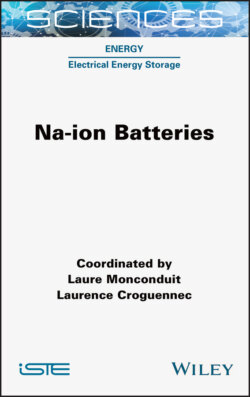Читать книгу Na-ion Batteries - Laure Monconduit - Страница 34
1.3.3. Moist air stability of O3-NaMO2 and surface coating
ОглавлениеMost O3-type NaMO2 are moisture sensitive and the stability of O3-NaMO2 against a moist environment and the easiness of handling are important for practical applications (Kubota and Komaba 2015; Zhang et al. 2019). During exposure to moist air, the water molecules react with air-instable NaxMO2 by (1) H2O insertion into the interlayer spacing between MO2 slab and the Na layer (Park et al. 2007), (2) oxidation of transition metal ions with the simultaneous removal of Na+ ions (Huang et al. 2005; Monyoncho and Bissessur 2013) and (3) H+/Na+ exchange (Blesa et al. 1993). (1) H2O insertion is often observed for Na-deficient phases such as O3-related Na0.3NiO2 and P2-type NaxMO2 (Legoff et al. 1993; Paulsen and Dahn 1999) and leads to the expansion of the interlayer spacing and then to exfoliation and crack generation at the particle surface after a drying process for cell assembly. Na removal in the (2) and (3) processes results in the further reaction with CO2 and H2O in air to form NaOH, NaHCO3·nH2O, Na2CO3·nH2O, etc. (Huang et al. 2005; Monyoncho and Bissessur 2013) and the sodium salts containing water are formed on the particle surface, which was confirmed by You et al. with subnanometer surface-sensitive time-of-flight secondary ion mass spectroscopy for O3-NaNi0.7Mn0.15Co0.15O2 (You et al. 2019). They further found that nickel ions gradually dissolve from the bulk to form NiO and accumulate on the particle surface. The accumulated species on the surface are insulating and lead to an increase in interfacial resistance and deteriorated electrochemical performance (You et al. 2019). Thus, surface coating is very effective and some researchers applied to O3-type materials. Carbon-coated O3-NaCrO2 (Yu et al. 2015), Al2O3-coated O3-Na[Ni0.6Co0.2Mn0.2]O2 (Hwang et al. 2017a) and ZrO2-coated O3-NaNi0.7Mn0.15Co0.15O2 (You et al. 2019) have demonstrated superior rate performance and suppression of the surface degradation owing to the inert carbon, Al2O3 and ZrO2 layers. Hwang et al. (2017a) revealed that ca. 20-nm-thick Al2O3 coating on the periphery of the primary O3-Na[Ni0.6Co0.2Mn0.2]O2 particles remained intact and served as a protective layer against HF attack in the cell. NaF is deposited on bared O3-Na[Ni0.6Co0.2Mn0.2]O2 particles during charge–discharge cycles, resulting in thick layer on the surface evidenced with X-ray photoelectron spectroscopy (XPS). Al2O3 coating successfully suppresses formation of a thick NaF deposition layer on the surface of the O3 materials due to HF scavenging in the electrolyte to form AlF3 by the proposed following reaction:
[1.1]
Formation of an AlF3 layer on the outermost surface of the Al2O3 coating protects the O3 materials and improves rate performance, coulombic efficiency and capacity retention of the O3-type materials. In order to obtain a large reversible capacity by charging to high voltage, surface protection of O3-type materials is necessary to capture HF generated from the electrolyte as well as to supress the reaction with moist air, leading to superior electrode performance in Na cells.
Instead of the surface coating process, air-stable O3-type materials have been extensively studied recently. According to the discovery of air-stable P2-Na7/9[Cu2/9 Fe1/9Mn2/3]O2, Li et al. (2015) also synthesized air-stable O3-Na0.9[Fe0.30Mn0.48Cu0.22]O2 (Mu et al. 2015) and then O3-Na[Li0.05Mn0.50Ni0.30Cu0.10Mg0.05]O2 (Deng et al. 2018), O3-Na[Ni0.45Cu0.05Mn0.4Ti0.1]O2 (Yao et al. 2017) and O3-NaNi0.45Zn0.05Mn0.4Ti0.1O2 (Mariyappan et al. 2020). Although the HF scavenging property of the air-stable materials is unknown, the air-stable surface leads to the suppressed surface degradation in contact with moist air and results in the stable surface even during charge–discharge (You et al. 2019). All these air-stable materials contain divalent metal ions such as Mg2+, Cu2+ and Zn2+, indicating that substitution of ionic divalentmetal ions is effective to enhance the moist air–resistant property. Selection of doping metals as well as transition metals is, therefore, important in designing ternary and quaternary 3d transition metal systems to enhance the air stability, suppressing the surface degradation in contact with moist air and to achieve excellent electrochemical performances with smooth voltage profiles without irreversible phase transitions during charge and discharge processes.
